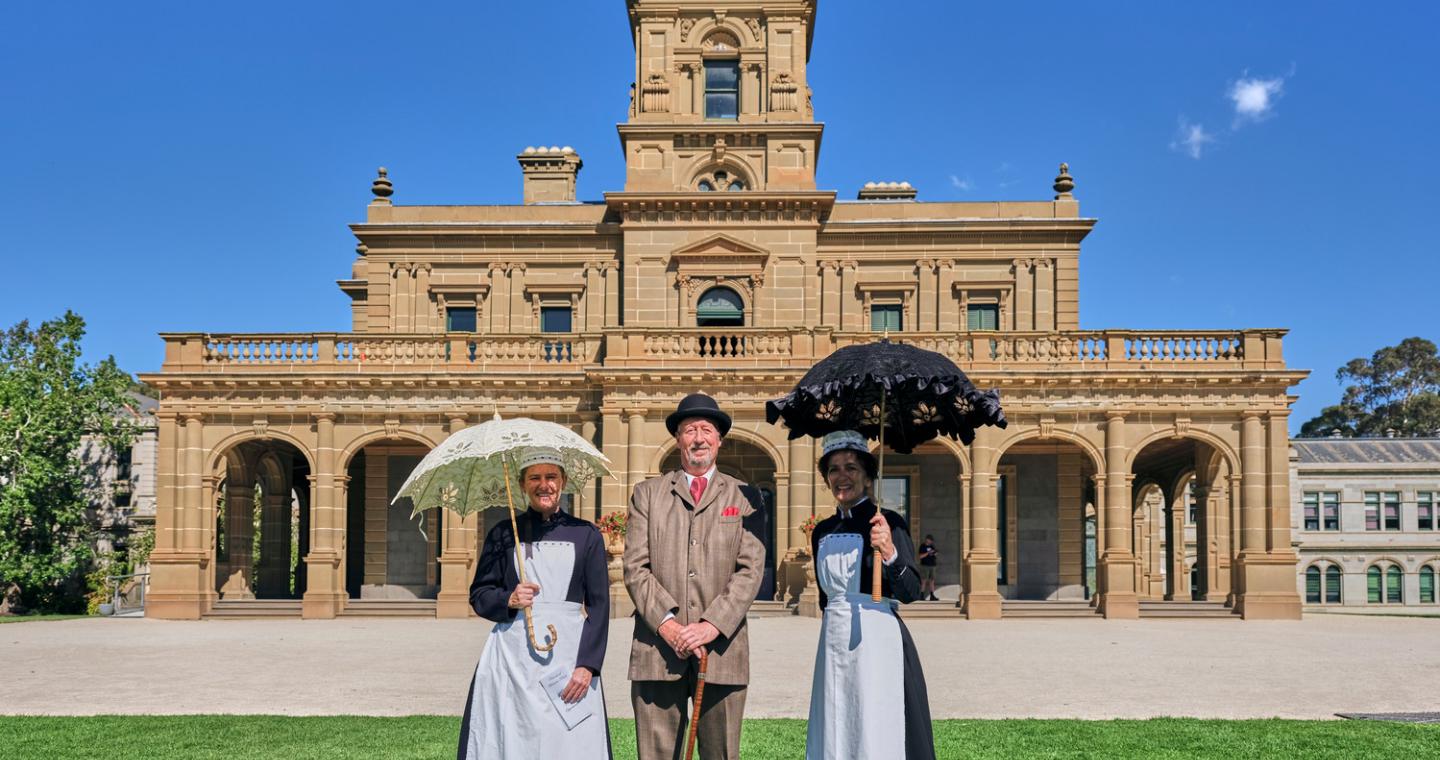
From lavish parties to a movie backdrop or place of prayer, Werribee’s most famous address has a history as rich as its ornate design.
Travel writer, Belinda Jackson uncovers the history of Werribee Park Mansion.
When Scottish emigrant Thomas Chirnside landed on the docks in Adelaide in 1839, he had just £100 in his pocket. When he died 46 years later, his home was the Werribee Mansion and he was master of Werribee Park, a pastoral lease that stretched from Point Cook to beyond the You Yangs mountain range.
Back home in Scotland, the Chirnside family wasn’t wealthy, but Thomas and his brother Andrew, who also emigrated to Australia, dreamed of riches in a country where land and manual labour were cheap, and incredible fortunes were being made from Australia’s high-quality wool.
The Chirnside brothers began trading in cattle and buying up properties around the Grampians and in South Australia before settling on Werribee to create their empire. Built in 1877, the sandstone mansion was their grand statement of wealth. The Renaissance Revival mansion featured elegant colonnades of arches, sweeping staircases and a tower looking across the 32,000 hectares of Werribee Park.
Picnic days, horse races, dances and fox hunts – it was a wild ride for the Chirnsides, who lived lavishly in their ornate mansion, attended by a league of servants.
“There were two classes living side-by-side in the one house; one with absolute, ridiculous wealth and the other in poverty,” says Alaine Beek, a former tour guide at Werribee Park Mansion and playwright of What Was That? which is performed in the mansion at night.
Thomas imported deer, foxes, hares and game birds from England to complete the picture of a wealthy, successful squattocracy (and by doing so, giving the suburb Deer Park its name). However, Werribee was still a full day’s horse ride from the centre of Melbourne, best known as an overnight stop on the way to the young town of Geelong, causing one city socialite to snub it as simply a ‘palace in a paddock’.
But what a beautiful paddock! The mansion was surrounded by formal gardens designed by WR Guilfoyle, curator of Melbourne’s Botanic Gardens, who transplanted classically English ideas to the Werribee plain. He created the circular, parterre garden, the lake, grotto and glasshouses that visitors loved to parade around in the past, and still do today.
“The social norms were so strict, and the wealthy clung to ridiculous traditions such as heavy, constraining clothing worn in the heat of the Australian summer,” says Alaine. “It was a way of showing your status, so they hung onto it for grim death.”
Australians didn’t like the get-rich-quick squattocracy, and by the 1880s, the wool market was starting to crash. Thomas, a bachelor for life, suffered health issues, and letters preserved in the State Library of Victoria talk of his ‘bouts of melancholy,’ as depression was then known.
He could see the lifestyle coming to an end. And it did.
Thomas committed suicide, and Andrew died just three years later. With Australia’s rural economy in tatters, Andrew’s sons sold off much of the land very quickly until the estate, diminished to around 2000 hectares, was bought by the Catholic Church in 1923.
The house began a new life as St Joseph’s Seminary for trainee priests, and to house its booming population, it added an extra wing to the mansion.
After 54 years as a church institution, the property was bought by the Victorian Government in 1973 after two students and a teacher at Werribee High School wrote to the Victorian Premier, Dick Hamer, asking him to preserve the open spaces of the property for future residents of Werribee. Surprisingly, the Premier agreed. In 1983, more Chirnside land behind the mansion was sectioned off to become the Werribee Open Range Zoo and the National Equestrian Centre.
However, the seminary wing lay desolate for three decades until 2000, when it was transformed into the five-star, 91-room Lancemore Mansion Hotel Werribee Park. Hotel guests can still touch history, admiring the stained glass in the library or by spending the night in one of the hotel’s 51 Heritage rooms, which once housed students of St Joseph’s Seminary.
Otherwise, you can tour the 60-room Werribee Mansion for a hit of history. Even if you haven’t visited, you may recognise the mansion’s extravagant interiors from films and TV shows including several of Miss Fisher’s murder mysteries, the haunted-house thriller Winchester starring Helen Mirren, the 2018 remake of eerie Picnic at Hanging Rock and even (much less scary) Neighbours.
The Chirnside’s bluestone woolshed is now a feature of the Australian Trail at the Werribee Open Range Zoo, and their homestead’s lavish lawns now are also the site of the Victoria State Rose Garden, which features more than 5000 rose bushes in the six acre gardens. Planted in the shape of a five-petalled Tudor Rose, stem and the Federation leaf, it took 10 years to create the rose gardens, which opened in 1986.
Werribee Park is home to Werribee Mansion, Lancemore Mansion Hotel, the Victoria State Rose Garden, the National Equestrian Centre and Chirnside Polo Ground, Shadowfax Winery, the Werribee Golf Course and the Werribee Open Range Zoo.
Delve further into the personalities of Werribee Park with a performance of What Was That? a roaming play set in the 19th century and performed at night, moving through the rooms of the Werribee Park Mansion.
